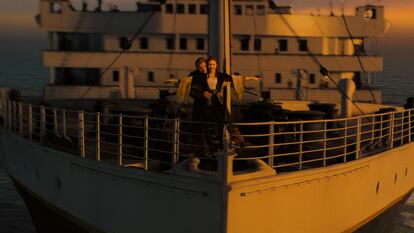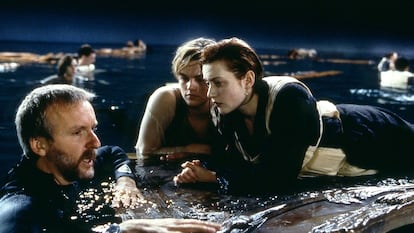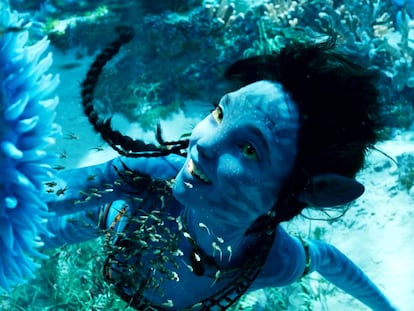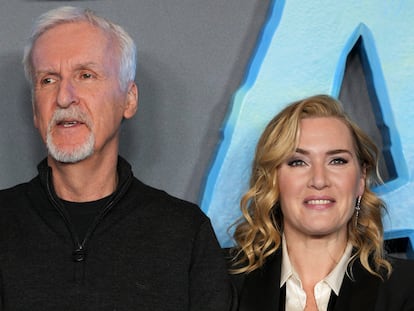James Cameron: ‘Titanic was never motivated by an ambition to sweep the box office’
The famous film rides a wave of nostalgia back into theaters 25 years after its first release

The RMS Titanic struck an iceberg and sank in the early morning hours of April 15, 1912, killing 1,496 of the 2,208 people on board. An ocean liner that had taken three years to build went down in less than three hours during its maiden voyage.
On a video call with EL PAÍS, James Cameron recalled how “as a child in the 1960s,” the Titanic story impressed him. Not the real story, but The Last Night of the Titanic, a British film released in 1958 that spectacularly recreated the famous shipwreck in exquisite black and white. In 1985, Cameron heard the call when ocean explorer Robert Ballard found the wreck at 12,415 feet (3,784 meters). Twelve years later, he released Titanic in 1997, still the third highest-grossing film in history 25 years later (although it might soon be eclipsed by another Cameron movie – Avatar: The Way of Water). James Cameron brings out something new about the ship and its demise every five years or so. This time, he released a remastered 3D version of the film and starred in a documentary on whether Jack – the male protagonist played by Leonardo DiCaprio – could have somehow survived the wreck’s aftermath. “Even though I’m engaged in other projects,” he says from a New Zealand studio where he is doing more filming of the Avatar saga, “I still have a passion for Titanic.” That explains why he has been down to explore the wreck 33 times. Audiences are also still passionate about Titanic. Last week, the newly released version grossed worldwide $22.3 million (€20.9 million), trailing only Avatar: The Way of Water.

How important are the box office returns to Cameron? “This is not all about money. It’s important, of course, because it helps you commit the right amount of resources to other projects, and investors need to make money. But Titanic was never motivated by an ambition to sweep the box office,” said Cameron. In 1997, Cameron was not the man and filmmaker we know today. Considered a reliable director of action and science-fiction movies, he was not known as a storyteller, which meant his audiences were limited. “I was confident in my film, but those weeks when it not only remained at the top but kept getting bigger at the box office, wave after wave – that grabbed everyone’s attention.” Cameron laughs. “The box office matters to me because it means the audience enjoys what I do. Personally, I don’t need to make any more money. Titanic kept making money for months, and then came all the nominations and the Academy Awards.”
At the awards ceremony, he won 11 Oscars and shouted Jack’s famous line from the movie, “I’m the king of the world!” “I was thinking this morning that I haven’t changed much as an artist and storyteller,” said Cameron. “I might emphasize my interest in environmental conservation more now, but I cared about it back then… 25 years later, I think Titanic can be seen as a metaphor for climate change, for the danger that’s upon us.”
What drives Cameron, the man who holds the record for the deepest solo dive to the bottom of the Mariana Trench? An anecdote may explain the filmmaker’s competitive nature. After explorer Victor Vescovo made a dive to the ocean liner’s wreckage, he wrote a mocking email to Cameron. “I have seen Titanic on the Titanic.” Cameron famously replied, “That’s nice, but I made Titanic on the Titanic.”
What made a very long (194 minutes) love story with a proven star like Leonardo DiCaprio and the much lesser-known Kate Winslet so successful? “The public and I both enjoyed the film’s idealized romanticism and the passion between Jack and Rose,” said Cameron. “That mix of passion and chaos had worked before in films.”
The ‘Doctor Zhivago’ influence
Cameron quickly starts talking about the film that planted the seed for Titanic. “In Doctor Zhivago, David Lean combines a beautiful love story with the Russian revolution and some spectacular cinematography.” This also brings to mind Gone with the Wind, another successful combination of war and romance which, adjusted for inflation, is the highest-grossing film of all time. “I was intrigued by everything that happened during those two and a half hours while the ship sank. But I also knew I had to infuse a certain classicism when filming a story that happened 80 years earlier.” Perhaps the classicism of the great Russian novelists? “Before the iceberg appears, we spend two hours with the characters, building them and exploring their sentimental relationships and friendships. The disaster part comes later. But why do you remember the movie? Because it’s a love story.” Cameron suddenly recalls a rumor that circulated at the time. “I remember when they said that every teenage girl in the world had seen the film. That wasn’t entirely true because the math showed that other people were watching it. Titanic isn’t just a movie to see – Titanic is a movie that people want to experience with others. The significance of love is that it confronts you with human mortality – we all love, and we all die. That’s why people like to watch it again and again. We added another element on its 25th anniversary – nostalgia. Do you remember who you went to see Titanic with? Many people want to feel that emotion again.”
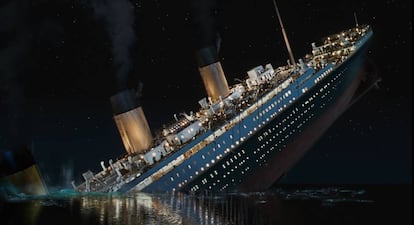
Cameron says he dove down to the RMS Titanic “because I needed to…. After visiting the wreck, I realized that I had stored the actual size of the ocean liner in my subconscious. I also realized how committed I was in the film to accurately depicting what happened to the victims and in the accident.”
Cameron accurately used all the knowledge available in the 1990s, but new research has proven the ship did not sink precisely as depicted on the screen. “The fans are always there, providing clues. Every day, someone talks to me about Titanic, or I get a letter about Jack’s death,” he said. It’s a discussion that has dragged on for 25 years – did DiCaprio’s character have to die? Could he have been saved along with Rose? National Geographic’s documentary film Titanic: 25 Years Later with James Cameron delves into that topic. “From the perspective of narrative, I needed that death,” said the filmmaker. The documentary recreates several plausible scenarios of Jack’s final minutes. The wooden plank would have sunk with two people on top of it. If both had clung to the plank half-submerged in the icy water, they would have quickly succumbed to hypothermia. Jack could have only been saved by some unlikely confluence of events. “Maybe [with a lifevest and a lot of luck] he could have held on until a lifeboat arrived. Jack could have survived... but there are a lot of variables,” said Cameron. Most of those who got off the sinking ship died of hypothermia in the waters off the coast of Newfoundland (Canada) before rescuers arrived on the scene two hours later. “In hindsight, perhaps I should have used a smaller board in the movie,” he jokes.
Sign up for our weekly newsletter to get more English-language news coverage from EL PAÍS USA Edition
Tu suscripción se está usando en otro dispositivo
¿Quieres añadir otro usuario a tu suscripción?
Si continúas leyendo en este dispositivo, no se podrá leer en el otro.
FlechaTu suscripción se está usando en otro dispositivo y solo puedes acceder a EL PAÍS desde un dispositivo a la vez.
Si quieres compartir tu cuenta, cambia tu suscripción a la modalidad Premium, así podrás añadir otro usuario. Cada uno accederá con su propia cuenta de email, lo que os permitirá personalizar vuestra experiencia en EL PAÍS.
¿Tienes una suscripción de empresa? Accede aquí para contratar más cuentas.
En el caso de no saber quién está usando tu cuenta, te recomendamos cambiar tu contraseña aquí.
Si decides continuar compartiendo tu cuenta, este mensaje se mostrará en tu dispositivo y en el de la otra persona que está usando tu cuenta de forma indefinida, afectando a tu experiencia de lectura. Puedes consultar aquí los términos y condiciones de la suscripción digital.
More information
Archived In
Últimas noticias
Most viewed
- Sinaloa Cartel war is taking its toll on Los Chapitos
- Oona Chaplin: ‘I told James Cameron that I was living in a treehouse and starting a permaculture project with a friend’
- Reinhard Genzel, Nobel laureate in physics: ‘One-minute videos will never give you the truth’
- Why the price of coffee has skyrocketed: from Brazilian plantations to specialty coffee houses
- Silver prices are going crazy: This is what’s fueling the rally
